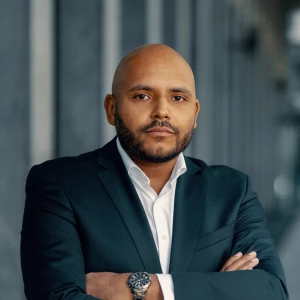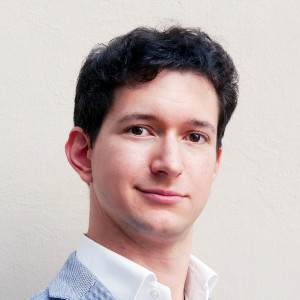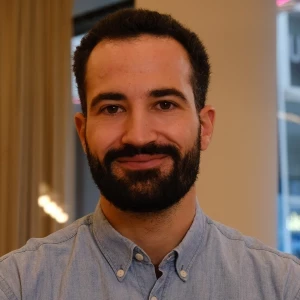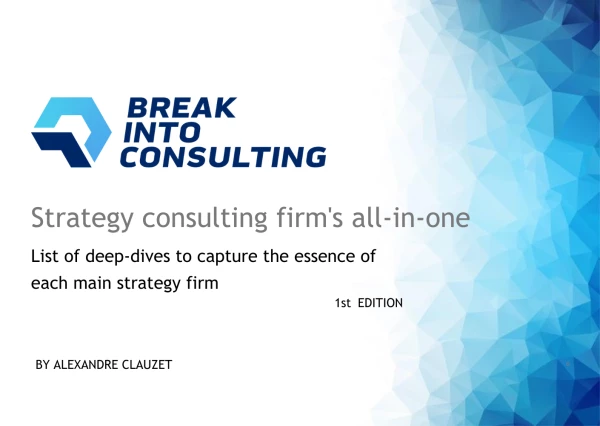Hi everyone, I just want to make sure if I understand the difference between brainstorming and structuring correctly here, is brainstorming more of a sub-structuring where you focus on one specific area/topic from your structuring framework? Also, is it common for interviewers to ask for some time to come up with a structure on brainstorming just as we put some time also for structuring in the beginning of the case?
Structuring Framework vs. Brainstorming


Hi,
Let me try to break it down for you (long answer):
Frameworks: more open-ended, usually involving many different areas that need to be analyzed (interviewer is assessing structure/MECEness)
- Example: should a fashion retailer invest in a new Flagship store in the center of London city?
- High-level approach:
- Ask clarification questions (it's very important to ask about anything you didn't understand, and to crearly understand the situation)
- Ask for some time to think about the question, gather your thoughts and define the categories in your structure
- Define the key questions in each category that you need to answer in order to get to the root cause of the client's problem. These should be specific to the case in question. Avoid generic questions that apply to every industry like “Who are the client's customers”
- While thinking about the key questions, you should also build your hypotheses in the back of your mind. Each question should be asked with the goal of proving an hypothesis is right or wrong - don't ask questions just for asking
- Now depending on the type of interview, you migh need to highlight the areas you consider a priority or it will be pointed out by your interviewer. In any case, be prepared to discuss the analyses you would do to test your hypotheses.
Brainstorming: more specific questions, usually related to one single topic (interviewer is assessing creativity/business acumen)
- Example: A fashion retailer sees a sudden increase in online sales but a decrease in store visits. What could be some reasons for this shift in consumer behavior?
- High-level approach:
- Don't just say a laundry list of ideas that come to your mind. Although you're not supposed to take time to structure your answer (or take just a few seconds), you are still supposed to be structured in the way you share your thoughts, but using much simpler structures (vs. framework questions)
- Use issue trees to quickly divide your question into 2-3 simple blocks (doing this quickly on your feet requires some pratice, but it's possible). For the example question, you could look at “1. Internal changes” and “2. External changes”, and inside 1. you could look at “1.1. Changes in online stores” and “1.2. Changes in physical stores”. Then populate each block with some ideas (e.g., “1.1.1. Improvements in delivery” inside “1.1. Changes in online stores”)
- Prioritize the key idea(s) you think was the main driver of the problem. Bonus points if you add some more structure to this idea (e.g., split 1.1. into “1.1.1 Drop in delivery price”, “1.1.2 Increase in speed”, “1.1.3 Better geographical coverage”)
- Create your ideas/hypotheses for each of the prioritized blocks (e.g., “New express next day delivery” inside 1.1.2)
I know this is a long answer, but hopefully can help you better understand the differences between the two types of questions, and how a very strong candidate would answer each. Of course remember this is a theorethical approach that you should practice at home to create the righ mindset for the interview day, but be flexible to adapt if needed during the real interview.
Feel free to DM me if you have any additional questions!
Best,
Tiago

Great question and a common one!
Simple answer: in consulting, a brainstorming answer should always be a structured one.
However, the structure to that brainstorming answer does not need to be as complex as a framework.
For example, in the interviews I used to give at BCG, I would ask a brainstorming question in my case. What I was expecting is an answer that is less structured than the case framework (aka no need for a whole issue tree there, so more of a lighter structure rather than no structure), but more structured than a random list of items.
So if the question is “what are some factors that could influence market growth?”, I would not expect a whole issue tree to answer there, but something like “There are two main categories of factors, X and Y”, and then all elements nested under these two categories.
In terms of requiring time to think, you can ask for a bit of time before answering. But aim to keep it shorter than the time needed to do a full fledged framework.
Hope this helps,
Ariadna

Hi there,
Both questions belong to Structuring in the broader sense.
The way you approach them should be very similar with regards to
- Steps to get there (logical approach)
- Thinking techniques (to generate ideas)
- Communication
The main difference is that the framework at the beginning of a case should help you analyze the issue/find an answer to the case question, whereas brainstorming is more of a narrow deliberation of a specific topic.
For instance, at the beginning of a case, you might have to analyze why the profit of a company has gone down. Later on, you find out that customer satisfaction has dropped, which led to lower sales. As a follow-up brainstorming, the interviewer might ask about potential issues with the customer experience you can think of or ways to improve customer satisfaction.
The main mistake that I see with new clients with regards to brainstorming is that they treat it as a laundry list of ideas, rather than a structured thinking exercise (where they should go broad and deep).
All the best,
Florian

Hi,
When we talk about the structure of a case, we're referring to the systematic approach to analyzing and solving the problem. On the other hand, structuring (as a verb) is a common tool used in various contexts by business professionals. You can structure anything—your verbal communication, written content, or an email.
When we say you need to structure your brainstorm, we mean organizing your ideas systematically. It's not about randomly shooting ideas, but about using a methodical approach to list and organize your thoughts. This means you can (and definitely should) be creative in your thoughts, just be structured in the way you communicate them.
Best,
Oliver

Hi,
This question shows that you have a big confusion on some crucial aspects.
Regarding your first question:
There is NO difference between these two concepts. In MBB interviews, Brainstorming IS a type of case (or a question embedded into a case) which is about idea generation, and it needs to be approached as every other question: You need to learn how to build a ROBUST LOGIC / STRUCTURE for such situations.
In essence, you need to learn how to operationalize an aspect (e.g., the client’s goal), then break this aspect down into its constituting elements, and then develop ideas against each sub-element on how to influence it into your desired direction. THIS is what you need to show in MBB interviews. And this is why books like Case in Point, Case Interview Secrets etc. are horrible and in fact RESPONSIBLE for thousands and thousands of candidates' failures!
Regarding your second question:
If we are talking about a Brainstorming type of case, then you are expected to take time (after the prompt and your clarifying questions) to work on your structure.
In situations when the interviewer asks you to brainstorm about some ideas during the case, then it is your responsibility to align with your interviewer and manage expectations. This means that you should ASK your interviewer whether it will be OK for you to take some time to think about your structure, or whether it is expected for you to do this in a very short amount of time (e.g., thinking about a couple of logical ideas without too many details).
My tip:
Get someone who REALLY understands consulting (and who did not just have a 1-3 years stint at it) to coach and mentor you on how to properly think through such problems. Then you will eat all these other candidates for breakfast. :)
Cheers, Sidi
_______________________
Dr. Sidi Koné
Former Senior Engagement Manager & Interviewer at McKinsey | Former Senior Consultant at BCG | Co-Founder of The MBB Offer Machine™

Hi there,
1) Is brainstorming more of a sub-structuring where you focus on one specific area/topic from your structuring framework?
A brainstorming question is simply a question asked during the case, related to identifying multiple drivers responsible for an outcome (eg Tell me 5 ways to increase volume). Whether the brainstorming question is related to the original question or not is irrelevant (sometimes the interviewer might go off-topic). To answer a brainstorming question, you should ideally use a structure.
2) Is it common for interviewers to ask for some time to come up with a structure on brainstorming?
Yes, it is totally fine to ask for time if they ask to brainstorm during the case.
Best,
Francesco

Structuring is a skill.
The initial framework of a case and the brainstorming case you sometimes get later in the case, are examples of where you can exercise that skill.
And yes, for both the upfront framework and the brainstorming question, you can and should take time.
FYI - sometimes you are asked a brainstorming question in the beginning rather than a framework question.
You might also find this article helpful:
Best,
Cristian

I would suggest a different way to think about this.
A framework is a just a structured set of points.
Those points can be either:
- Hypotheses for a diagnosis case
- Ideas for a brainstorming case
- Considerations for a decision case
In a case - you can encounter one or more of these situations. For example:
- You can be asked to diagnose for the reasons of declining profitability; and/or then
- You can be asked to brainstorm ideas for improving profitability; and/or then
- You can be further asked to help decide which idea is the best one to proceed with
So ideally each stage of the case interview can have its own structured set of points - its own framework.
And so it is also fine to ask for a few moments to put down your thoughts in a structured manner.
Let me know if you have further doubts - happy to resolve.

Hi there,
I would be happy to share my thoughts on your questions:
- First of all, both your overall approach to the case study and each qualitative question must be well structured. The only difference is that structuring a qualitative question is usually not as complicated as the overall approach to the case study.
- Moreover, if you need some time to develop a structure for a qualitative question, just ask for it - there's no point asking for time if you don't need it, or not asking for it if you do.
If you would like a more detailed discussion on how to best prepare for your upcoming interviews, please don't hesitate to contact me directly.
Best,
Hagen

Both require structuring.
Actually what you are referring to is
1) Providing an approach → how you would decide on something or act to solve this problem
vs.
2) Providing a set of possibilities or explanations (in a structured way) → what are the possible explanations or courses of action
You can always ask for some time to structure.














